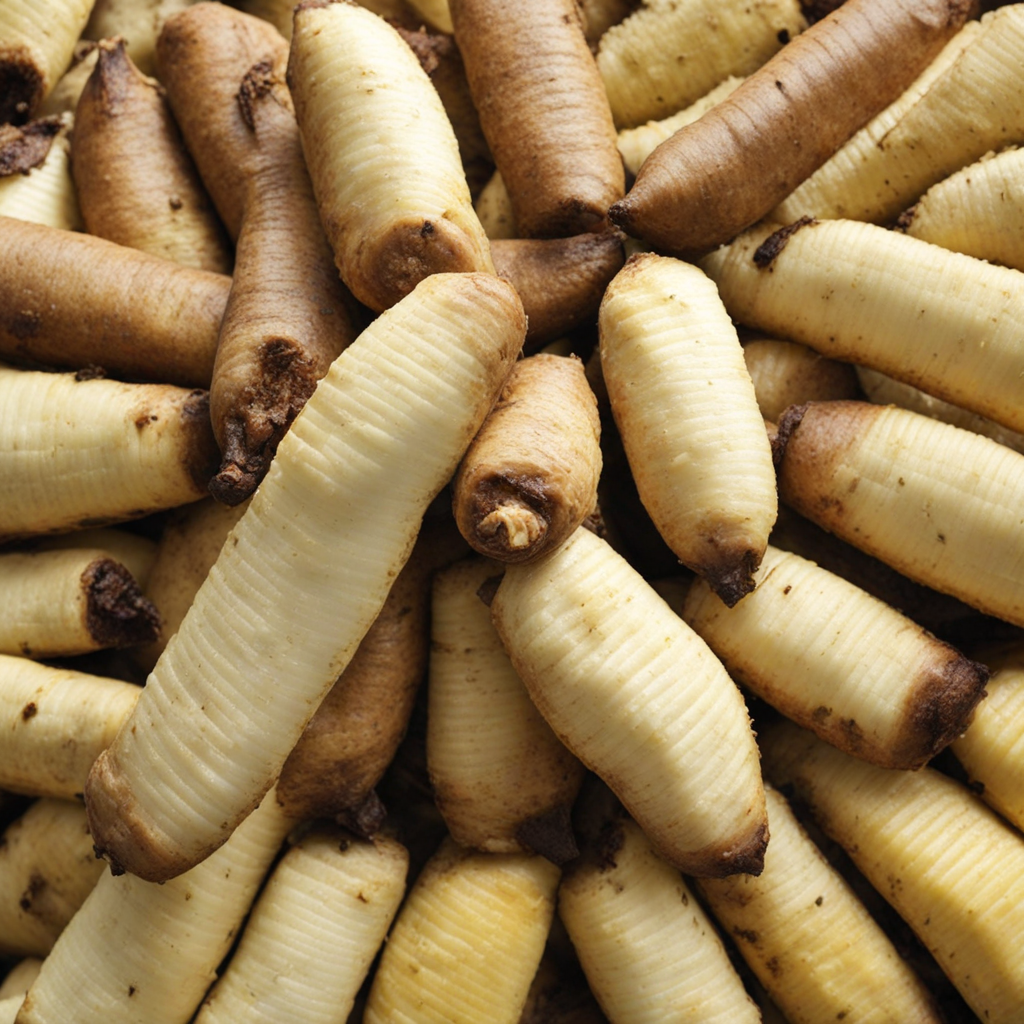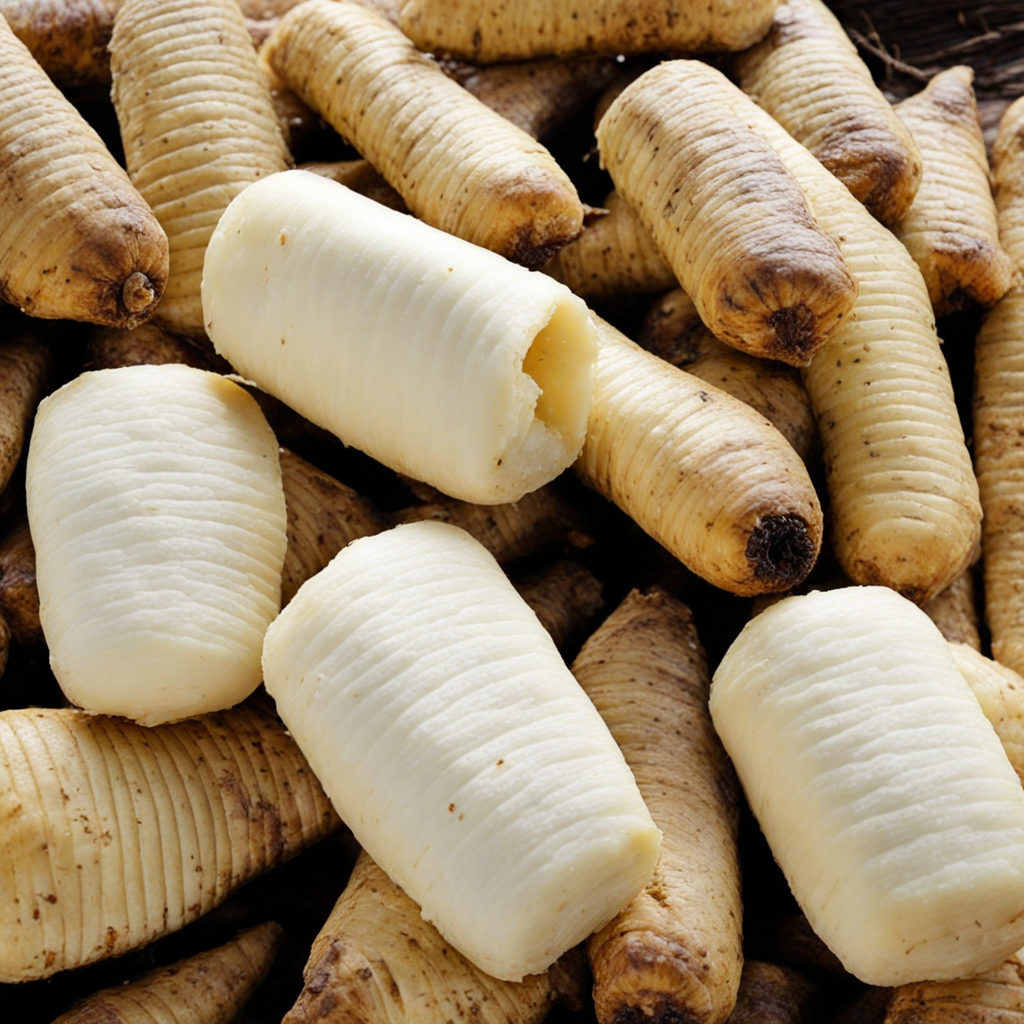Imyumbati
Imyumbati, a traditional Rwandan dish, is a delightful culinary experience that showcases the rich agricultural heritage of the region. It primarily features the starchy root vegetable known as sweet potato, which is cultivated extensively in Rwanda's fertile soils. The sweet potatoes are often boiled or steamed until they reach a tender, fluffy texture, making them a comforting staple in many households. This dish can be enjoyed on its own or served alongside various stews and sauces, enhancing its flavor profile and nutritional value. What sets Imyumbati apart is its versatility and the unique flavors that can be incorporated into the dish. While the sweet potatoes themselves have a naturally sweet and earthy taste, they can be paired with ingredients like garlic, onions, or local spices to create a more complex flavor. Additionally, Imyumbati can be mashed or blended into smoothies and desserts, allowing for both savory and sweet variations that appeal to a wide range of palates. The dish often embodies the essence of Rwandan cooking, which emphasizes fresh, locally-sourced ingredients. Imyumbati is not just a meal; it is a cultural experience that reflects the communal and familial aspects of Rwandan life. It is often prepared during gatherings, celebrations, or family meals, symbolizing togetherness and sharing. The act of enjoying Imyumbati with loved ones fosters a sense of community and connection. For anyone looking to explore new flavors, Imyumbati offers a beautiful introduction to Rwandan cuisine, inviting diners to savor the simplicity and richness of this beloved dish.
How It Became This Dish
Imyumbati: A Culinary Treasure of Rwanda #### Origins and Historical Context Imyumbati, often referred to as Rwandan sweet potato, is a staple food that holds a significant place in Rwandan cuisine and culture. The origins of this versatile tuber can be traced back to the Andean region of South America, where sweet potatoes were domesticated over 5000 years ago. However, it was during the transatlantic exchanges of the Columbian Exchange in the 16th century that sweet potatoes made their way to Africa. In Rwanda, imyumbati quickly adapted to the local climate and soil conditions, becoming a vital crop for sustenance. The fertile volcanic soils of the region, particularly around Lake Kivu, provided an ideal environment for its cultivation. As the sweet potato spread throughout the country, it became not just a food source but also a symbol of resilience and adaptability, reflecting the Rwandan people's ability to thrive in diverse conditions. #### Cultural Significance Imyumbati is much more than just a food; it is deeply embedded in the cultural and social fabric of Rwandan life. Traditionally, it is harvested during the rainy season, and the act of harvesting is often a communal affair, bringing together families and neighbors. This practice highlights the significance of community in Rwandan culture, as well as the shared connection to the land. In Rwandan households, especially in rural areas, imyumbati is often served during meals as a staple accompaniment. Its nutritional value, rich in vitamins A and C, makes it an important part of the diet, particularly for children and those who rely on agriculture for their livelihoods. The versatility of imyumbati is showcased in various traditional dishes, whether boiled, roasted, or mashed, and it can be enjoyed with a variety of accompaniments such as beans, vegetables, or meat. Moreover, the sweet potato has also found its way into Rwandan folklore and storytelling. It is often mentioned in proverbs and songs, reflecting the appreciation of the crop in the cultural narrative. For instance, sayings that revolve around the virtues of hard work and perseverance often include references to the sweet potato, symbolizing sustenance and survival. #### Development Over Time As Rwanda has evolved over the centuries, so too has the cultivation and perception of imyumbati. In the early days, the sweet potato was primarily a subsistence crop, essential for survival in rural households. However, as Rwanda began to modernize and urbanize in the late 20th and early 21st centuries, the role of imyumbati began to change. The 1994 genocide against the Tutsi had a profound impact on Rwandan society, displacing many people and disrupting agricultural practices. In the aftermath, efforts were made to rebuild the nation, and agriculture became a focal point for economic recovery. Imyumbati played a crucial role in this process, as it is relatively easy to grow and can be cultivated on small plots of land. Agricultural programs and initiatives aimed at promoting sustainable farming practices often included sweet potato cultivation, helping to restore food security and provide livelihoods for many. In the 21st century, the perception of imyumbati has also shifted in urban areas. While it remains a staple in rural diets, it has gained recognition in urban culinary scenes as a healthy, nutritious food option. Chefs and home cooks have begun to experiment with traditional recipes, incorporating imyumbati into contemporary dishes. It is now not uncommon to find sweet potato fries, chips, and even desserts in Kigali's vibrant food markets and restaurants. #### Contemporary Culinary Uses Today, the versatility of imyumbati is celebrated in various culinary forms. Traditional methods of preparation, such as steaming and boiling, coexist with modern techniques like baking and frying. Sweet potato is often used in local dishes such as "isombe," a dish made with cassava leaves and peanuts, where boiled and mashed imyumbati adds a creamy texture. Moreover, the nutritional benefits of sweet potatoes have gained international attention, leading to increased interest in Rwandan cuisine on the global stage. Health-conscious consumers are drawn to the natural sweetness, vibrant color, and health benefits of imyumbati, which has inspired Rwandan chefs to create innovative dishes that highlight the tuber's unique characteristics. In recent years, there has also been an emphasis on food tourism in Rwanda, with culinary experiences becoming an integral part of the travel itinerary for visitors. Cooking classes that incorporate traditional dishes featuring imyumbati have become popular, allowing tourists to engage with local culture and cuisine in a meaningful way. #### Sustainability and Future Prospects As the world grapples with issues of climate change and food security, the cultivation of imyumbati represents a sustainable agricultural practice. Sweet potatoes are drought-resistant and can thrive in poor soil conditions, making them an ideal crop for smallholder farmers in Rwanda and beyond. In response to the ongoing challenges faced by farmers, organizations and NGOs have initiated programs to promote the cultivation of improved sweet potato varieties that are more nutritious and resilient. This not only supports food security but also empowers local farmers by providing them with the tools and knowledge to enhance their agricultural practices. #### Conclusion Imyumbati is more than just a food item; it is a symbol of Rwandan culture, resilience, and adaptability. From its origins in South America to its integral role in Rwandan society today, the sweet potato has evolved over time, adapting to the changing needs and circumstances of the people it nourishes. As Rwanda continues to grow and modernize, the story of imyumbati serves as a reminder of the importance of cultural heritage and the enduring connection between people and the land. Whether enjoyed in a traditional setting or reimagined in contemporary cuisine, imyumbati embodies the spirit of Rwanda—a spirit of strength, unity, and hope for the future.
You may like
Discover local flavors from Rwanda







